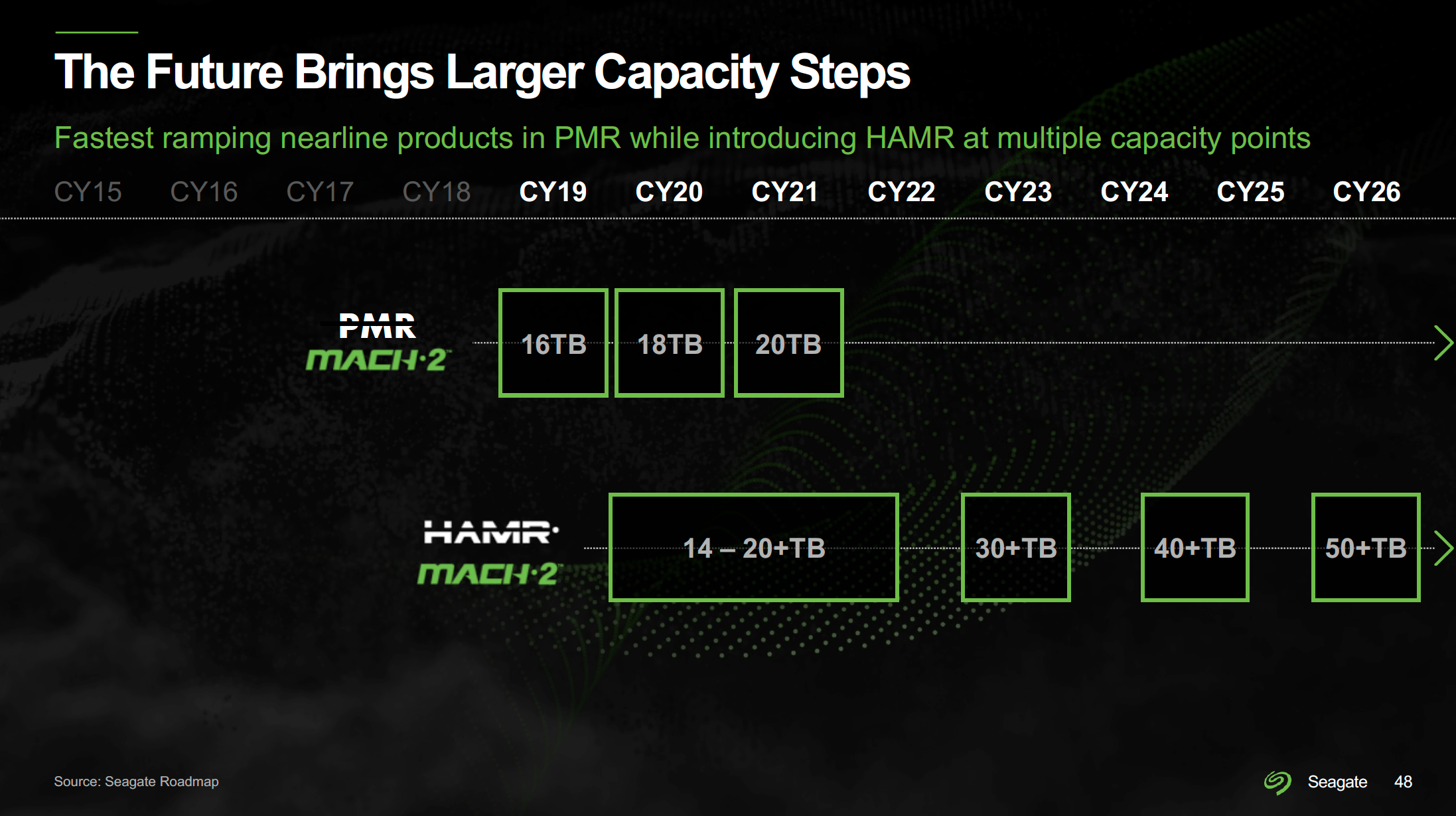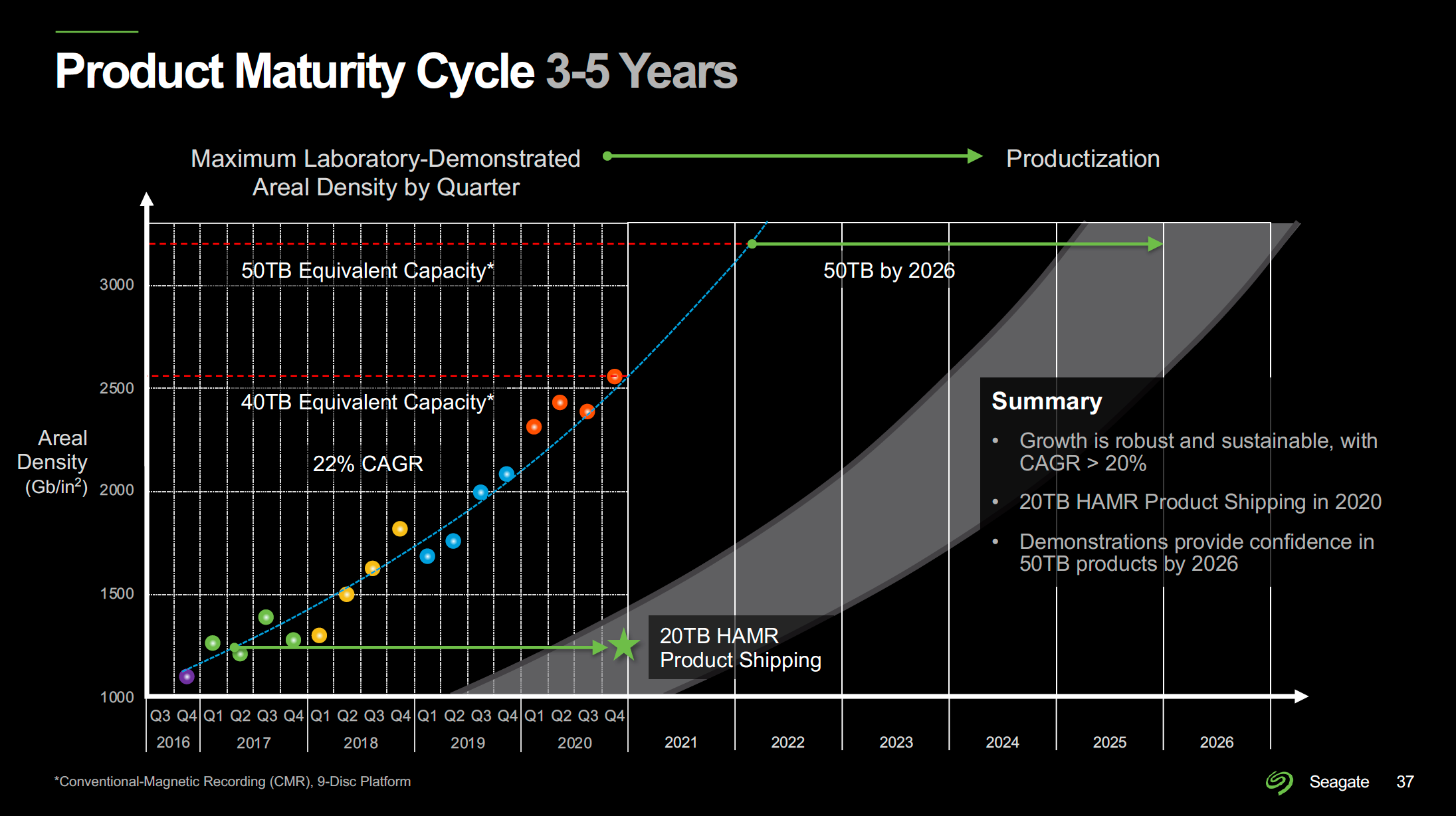Seagate: 100TB HDDs Due in 2030, Multi-Actuator Drives to Become Common
Seagate demonstrates path towards 120TB HDDs.
Seagate is on track to deliver ~50TB hard disk drives by 2026, ~100TB HDDs by 2030, and 120TB+ units early next decade, according to the company's recently revealed product and technology roadmaps. To hit capacity targets, Seagate will have to adopt new magnetic recording technologies. To ensure the high performance of its future drives, the company plans to leverage its multi-actuator technology more broadly. This tech doubles the performance of its hard drives, and it could become a standard feature on some of the company's product lines.
Boosting Capacity
Seagate says that it is on track to build a 50TB hard drive sometime in 2026 and a 100TB HDD in 2030. Right now, Seagate is shipping its 3.5-inch 20TB HDDs based on heat-assisted magnetic recording (HAMR) to select customers and as parts of its Lyve storage systems. HAMR will enable Seagate to increase the areal density of its platters at a 20% compound annual growth rate (CAGR), which means larger steps forward for hard drive capacities.
"As we approach the maximum useful capacity of PMR technology, each successive drive increases by 1TB or 2TB at a time," said Jeff Fochtman, Seagate's SVP of Business and Marketing at the company's Analyst Meeting. "With HAMR technology, it allows us to jump in steps of 4 terabytes, 6 terabytes, or even 10 terabytes at a time."
In a bid to build a nine-platter 40TB hard drive, Seagate needs to increase the areal density of its media to around 2600Gb/in2 (2.6Tb/in2). Seagate has already achieved such areal density, though it is unclear whether the company already has prototypes of hard drives running such platters, or only tests them on spinstands.
In any case, Seagate already has media technology that will power its products several years down the road. But it is going to take from three to five years before HDDs with platters featuring a 2600Gb/in2 (2.6Tb/in2) density will be ready for primetime as the company still needs to polish off the media technology as well as develop the appropriate head, drive, controller, and other electronics.
Modern hard drives based on perpendicular magnetic recording (PMR) technology use aluminum or glass platters with CoCrPt–SiO2 nanogranular magnetic films. Hard drives featuring HAMR rely on glass platters with magnetic films featuring high magnetocrystalline anisotropy to ensure very small grains. In particular, Seagate uses an iron platinum alloy (e.g., L10–FePt).
Today's HAMR media is expected to enable drives featuring 80TB ~ 100TB capacity, according to developers. But, for 3.5-inch HDDs with a ~105TB capacity and 5 ~ 7Tb/in2 areal density, new ordered-granular magnetic films will be needed as grains will get very small and tracks will get very narrow. But ordered-granular media is expected to be a relatively short stop before 'fully' bit patterned media (BPM) technology comes into play with an 8Tb/inch2 areal density.
"We see an opportunity to scale this design space with granular media into the range of 4 Tb/in2 to 6Tb/in2, at which point we plan to add patterning in one dimension through the use of ordered grain media," said John Morris, Chief Technology Officer of Seagate.
"This, we expect to be a steppingstone in media to open up the range of 5Tb/in2 to 7 Tb/in2. Then we will transition to fully patterned media to open up densities to 8Tb/in2 and even higher. With the areal density CAGR just introduced, we have a path to 10TB per disk by 2030. This then represents our outlook for technology limits over the next 10 to 15 years."
Boosting Performance
Advancing the capacity of hard drives at a rapid pace is important to keep Seagate's HDDs competitive, but capacity is only a part of the equation. Sequential read/write speeds, as well as random IOPS-per-TB performance, are also important. While read/write speeds are getting higher along with areal density, IOPS-per-TB performance drops as the capacity of hard drives increases. Datacenter operators want hard drives to offer more or less similar IOPS-per-TB performance since this affects their Quality-of-Service. If IOPS-per-TB declines, data centers have to mitigate it somehow, which requires additional investments.
A straightforward way to increase the IOPS-per-TB performance of an HDD is to use more than one actuator with read/write heads, and this is exactly what Seagate is set to do. Using two actuators instead of one can almost double throughput as well as IOPS-per-TB performance, which is tremendously important for data centers. Furthermore, doubling the number of actuators also halves the time Seagate needs to test a drive before shipping, as it is faster to inspect eight or nine platters using two independent actuators, which lowers costs.
For now, Seagate's dual actuator Mach.2 technology is used for experimental drives based on PMR that are available to dozens of customers, but it will eventually be used in commercially-available HAMR HDDs. When Seagate's nearline and enterprise hard drives hit capacities higher than 30TB, dual actuator technology will become a must-have feature in a bid to guarantee IOPS-per-TB performance on current (~16TB HDD) levels.
"Although Mach.2 is ramped and being used now, it is also really still in a technology-staging mode," said Fochtman. "When we reach capacity points above 30 terabytes, it will become a standard feature in many large data center environments."
Get Tom's Hardware's best news and in-depth reviews, straight to your inbox.
Like all the other technologies, HDDs are getting more complex, and therefore manufacturing costs increase. Nonetheless, Seagate is confident that HDDs will be cheaper than SSDs on per-GB and TCO metrics for years to come.
"We believe that the TCO for hard disk drives and SSDs will stay approximately in equilibrium," said Morris. "Both SSDs and hard disk drives will continue to improve their value proposition, and storage demand for both will continue to grow. They are both critical enabling technologies for the growing datasphere, and their synergistic relationship in the data center infrastructure will persist."

Anton Shilov is a contributing writer at Tom’s Hardware. Over the past couple of decades, he has covered everything from CPUs and GPUs to supercomputers and from modern process technologies and latest fab tools to high-tech industry trends.
-
MarsISwaiting This is not good for the future of storage devices . HDD should die out by 2030 and SSD should replace them entirely .Reply
Imagine trying to backup a failing 100TB harddisk. Such high capacity demands speed. -
USAFRet Reply
This is a business use case, not for the typical home user.MarsISwaiting said:This is not good for the future of storage devices . HDD should die out by 2030 and SSD should replace them entirely .
Imagine trying to backup a failing 100TB harddisk. Such high capacity demands speed.
You build your backup plan around what you're going to use. A failing drive would just fail over to its mirror, which is not failing. Replace the dead drive whenever.
HDD still has a place alongside solid state. Ny NAS has 12 drives in or attached to it. 11 of the 12 are HDD. ~51TB space..
Not so very long ago, people were saying the exact same things about 1TB drives. "OMG! That's too much."
If I were to replace my NAS HDDs with SSD:
SATA III = $5000
NVMe = $8200
I'd rather buy another car. -
truerock Yes, absolutely... making full-backups of HDDs had and has become problematic.Reply
I was a data-storage product manager at a multi-national corporation.
Before I retired, we had given up on performing full-backups of HDDs on the weekends.
We had to use mirroring to off-site storage as the new data-recovery process.
Also, because of legal requirements, some of the mirrored HDDs had to be moved to Iron Mountain for long term storage.
When I retired the corporation was trying to get rid of the Iron Mountain requirements because it was becoming too difficult to create copies of the mirrored drives.
For my home PC, I have a 12TB HDD that stores multi-media files such as video, audio and pictures.
I use eSATAIII for backups to local external HDD storage and I have given up on full-backups.
I perform incremental backups only.
My PC was built in 2012. When I get around to building a new PC (probably early 2022) I will definitely need to have some type of mirroring set up for HDD backups with some type of automatic file-versioning built in. -
USAFRet I use Macrium Reflect, and Full/Incremental/Differential, as the particular system dictates.Reply
Somewhat modified since this was written, but it works for me:
https://forums.tomshardware.com/threads/what-is-your-backup-situation-at-home.2997205/ -
truerock Multi-Actuator drives is just 2 HDDs (or more) as far as I'm concerned. I'm assuming putting 2 HDDs in 1 HDD enclosure saves space and power. Performance would be about the same?Reply -
hotaru251 100tb hdd......couldnt even imagine how long it would take to notice/read/copy/verify in case a raid drive failed....Reply -
USAFRet Reply
If one of a pair fails, the RAID software should notify you immediately.hotaru251 said:100tb hdd......couldnt even imagine how long it would take to notice/read/copy/verify in case a raid drive failed....
No matter what the size. -
spongiemaster Reply
Notifications are instananeous, but his other points are valid. I run an Unraid server at home and the parity drive is 16TB. All drives are 7200rpm Seagate Exos drives. Solid performance drives by mechanical standards and it still takes over a day to complete the monthy array verification or rebuild the array if I replace a drive. 100TB drive would take almost a week without a significant speed up which no one is predicting.USAFRet said:If one of a pair fails, the RAID software should notify you immediately.
No matter what the size. -
USAFRet Reply
Right.spongiemaster said:Notifications are instananeous, but his other points are valid. I run an Unraid server at home and the parity drive is 16TB. All drives are 7200rpm Seagate Exos drives. Solid performance drives by mechanical standards and it still takes over a day to complete thr monthy array verification or rebuild the array if I replace a drive. 100TB drive would take almost a week without a significant speed up which no one is predicting.
That's why you have it fail over to an identical array.
Replace the 1 failed drive in Array 1 as needed. The system is still running 100% from Array 2.
100TB drives will happen.
Just like 1TB, 10TB drives were considered "large" at the time.






